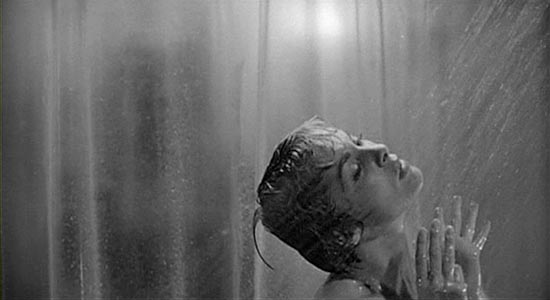
M O D E R N I T Y A N D T H E M A N I A C P a g e F o u r : T h e S h o w e r S c e n e |
 |
|
In his Sight and Sound review of Durgnat, Thomson reads this free-floating quality as inaugurating the '60s auteurist aspiration to "weightless sensation." Indeed, the swirling stained water running down the plughole at the end of the shower scene oddly anticipates the swirl of bubbles in that seemingly gratuitous high-angle shot of the coffee cup in Godard's Two or Three Things I Know about Her (1966). The figural excess of the opening shower montage that Brenez is aware of sees the film briefly flee the relentless narrative of Marion's drive. At one point, Marion squints into the pouring water and we are idly reminded of how she squinted through the rain on the windshield as she drove to the Bates Motel. Only then she was responding to the voices in her head as she imagined what her boss, her colleague, and the predatory Texan millionaire whose money she stole will make of her transgression. Norman Bates is not the only crazy with voices in his head, adding to the sometime delicious surmise that Norman and Marion will become an item.
But the awful truth is that the modern girl has fetched up in a dark, empty place. "Neither Miss America nor the girl-next-door any longer, she's stolen something--she's entered into lawlessness, and momentousness, and escaped banality," Harvey writes. As if to echo this flight from the mainstream, the daily American narrative, the shower scene is ripe for a reading on the level of the figural. Australian academic Warwick Mules defines the figural as "the resistive movement that exceeds resolution of the image to character and narration. The figural is an 'excess' that carries the image elsewhere." Echoing Marion's earlier jouissance, her "face becomes figural when it exceeds in its beauty/agony the resolution of character to plot. In the shower scene, where it ceases to be her terror and becomes instead detached, free-floating terror, borne along by the visual and aural affects…it's not that Janet Leigh's face (body) is the outward appearance of the violent death that the character endures, but the 'tearing away' of the body in its appearance as film image from the strict requirements of the plot, even if it is a necessary element to get the character murdered in a certain way." It is in this "tearing away" that Psycho not only announces the shift towards film as film that characterizes the cinephilia, and the modernity, of the '60s, but the "tearing away" of "Janet Leigh" from Marion Crane the narrated character, as it were, announces Leigh's status as emblem of that modernity. The image of a naked blonde in a shower, drenched and screaming, has become a flashback fetish in the cultural consciousness of our time.
The emblem is a recurring definition of the figural in Brenez. In writings on Abel Ferrara, she has discussed characters drained of three-dimensionality until only the Serial Killer, the Vampire, the Bad Lieutenant remain. We might argue, apropos Brenez, for Marion Crane, drained as she is of character, blood, life, as the Serial Victim, surely one of the most awful emblems of the modern world. Another concept Brenez evokes when discussing the figural is that of the effigy, a sculpture or model drained of personality. In her 1998 essay "The Actor in (the) Place of the Edit" (www.sensesofcinema.com), she writes "it rests on a logic of the effigy, of an actantial (actancielle) derealization which enlightens the performative (actorale) invention." In this light, perhaps we can see that final image of Marion sliding down the wall as anticipating the ghastly figure of Norman's mother's grinning skull, subjectivity become effigy.
In correspondence with me, Australian critic Adrian Martin has reflected that sometimes for Brenez the figural arises out of the stylistic work of the film. Delineated and shaped by that exacting cutting and the shrieking avant-garde score, the effigy descends from an extraordinary orchestration of visual and aural shock.

Page One: Introduction | Page Two: Janet Leigh in Touch of Evil | Page Three: Janet Leigh in Psycho
|